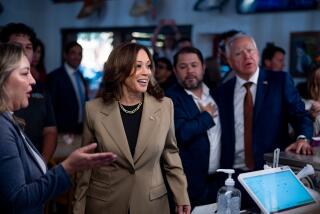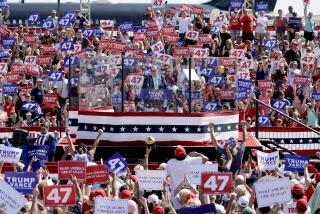For a Campaign in Motion, the Idea Is ‘Have Chaos, Will Travel’
- Share via
Take the chaos of a circus, the conversation of C-SPAN and the silliness of World Wide Wrestling. Throw in a ringmaster who enjoys discussing things like the Antiballistic Missile Treaty, a particularly unruly herd of reporters and lots of lost luggage.
This, pretty much, is the world of presidential campaign travel.
A typical day involves moving more than 100 people, including the candidate, his staff, dozens of reporters and security through stops in as many as six states per day.
“The whole thing has always amazed me,” said Curtis Wilkie, a Boston Globe reporter who has weathered eight presidential campaigns since George McGovern ran in 1972.
But for all its complexity, the punishing demands of campaign travel are probably lost on voters. Working behind the scenes, the campaigns create virtual traveling towns, setting up hotel rooms, banquet halls, lighting, food, telephone lines and plane flights--every day, seven days a week, in the heat of a hard-fought campaign.
The Frantic Pace Guarantees Snafus
The costs add up fast. Renting a Boeing 727 to fly around the country goes for about $8,000 an hour. Setting up the lights at an event to make the candidate look good on television can cost as much as $25,000.
When a campaign is in full swing, in fact, it’s not unheard of to spend more than $200,000 per day, with the media reimbursing the campaign for a good chunk of those costs, such as transportation and lodging.
The fast pace guarantees mistakes and snafus. A campaign leaves a trail of lost items across America--cellular phones, jackets, laptop computers, all get left behind in the hustle-bustle, to be recovered only through the miracle of Fed Ex.
The reason behind the incessant travel, of course, is to get the free exposure that comes with a news story--what political insiders call “earned media.”
“What’s a photo on the front page of the L.A. Times worth? What’s the front page of the New York Times? Everything I do is for earned media,” said Lanny Wiles, one of the select group that exacts a living from sorting out the chaotic logistics of a campaign. Wiles served as an advance man for President Reagan and, most recently, Sen. John McCain of Arizona.
But another big goal of advance work is to energize the crowd, which, in turn, energizes the candidate and the campaign.
“You want to bring out the emotion in people and make it an experience,” said Brian Montgomery, George W. Bush’s advance director. “We want to make it worth their time.”
A Reporter’s Query: ‘What State Are We In?’
A typical day begins with the dreaded Bag Call--the time each morning, often before dawn, when bleary-eyed press, staffers and security gather in a hotel lobby with their luggage to begin another 12-hour campaign day.
It’s not a happy time. Coffee intake is high, grumpiness universal. Instead of the usual chatter, there is silence.
Next, everybody piles onto buses or planes and follows the candidate from stop to stop. A VFW hall in Ohio. A drafty airport hangar in Michigan. A photo opportunity in an elementary school in Pennsylvania. Sometimes all before dinner.
The spots are usually carefully chosen weeks in advance. Al Gore flies to Detroit to announce a new program to improve fuel economy. Or Bush tours a health clinic in a poor St. Louis neighborhood to unveil a plan to build 3,000 such clinics.
It’s no coincidence that both sites are in crucial swing states.
“We try to mesh the message, the venue and the theme,” Montgomery said.
As campaigns move at warp speed, cities tend to lose distinction. It’s common for a reporter to look up suddenly from a keyboard and demand: “What state are we in?”
Candidates, of course, can never make that mistake. In each town, they usually have a line in their speeches to acknowledge the locale. Bush will frequently say how glad he is to be in Cleveland. Or Red Oak. Or Charleston.
Take a recent day on the Bush campaign.
The hyper-energetic candidate had eight separate meetings on a schedule that began at 7:50 a.m. in New Jersey and ended 12 hours and 1,267 miles later in Wisconsin.
The day included a tour of a charter school, a youth rally at an airport and several private receptions. One thing the day didn’t include was much news. Although local papers did note Bush’s appearances, many larger news outlets, the Los Angeles Times among them, didn’t even report on the day’s activities.
The main reason is the stump speech. A candidate running for office always--always, always, always--gives the same speech at every appearance, every day. On the day in question, Bush delivered one speech over and over, doing nothing “new,” but guaranteeing some coverage of his presence with local television stations and newspapers.
The Stump Speech Again, and Again . . .
It’s called staying on message, or message discipline in the parlance of the trade. The idea is to make sure that each crowd that shows up hears the same thing and leaves with the same idea.
Bush has an exceptional gift for it. Since last year, he has been delivering more or less the same speech, interspersed with an occasional new announcement or policy speech. Most of the reporters covering him have the standard stump speech memorized and take notes by using a single word to represent a tale.
A call to increase the number of volunteers working in faith-based programs becomes “AOC”--short for what Bush calls armies of compassion. And “sword” refers to Bush’s plan for a foreign policy based on having a strong military--a “sharpened sword,” in his words.
This routine, however, is interrupted by the breakdowns inherent in hectic travel. One night in Washington state, McCain’s plane ran off the runway, lodging itself in several feet of mud. The simple solution: Workers placed chunks of wood under the wheels, and a truck hauled it out.
But when a suspicious emergency light forced Bill Bradley’s campaign plane to return to St. Louis shortly after takeoff, his staff was forced to improvise. A plane of comparable size was unavailable, so staffers hurriedly procured three smaller Lear jets and, by next morning, the campaign was traveling again.
Times staff writers Maria L. La Ganga and Matea Gold contributed to this story.
(BEGIN TEXT OF INFOBOX / INFOGRAPHIC)
Two Days on the Trail
Day after day, the candidates seeking the presidency crisscross the country looking for votes, often visiting several cities and a few states in just a few hours. As an example, consider this packed--and rather typical--schedule recently followed by George W. Bush.
*
Day 1
MARCH 28, 2000
6:30 a.m. CST Austin, Texas: Day begins with baggage sweep
by Secret Service
11:00 a.m. EST The Plains, Va.: Bush holds private reception
1:40 p.m. Reston, Va.: Bush gives speech at Sallie Mae headquarters
6:05 p.m. Parsippany, N.J.: Bush holds private reception at Hilton Hotel
6:45 p.m. Parsippany, N.J.: Bush gives speech at Hilton
8:15 p.m. Manville, N.J.: Bush participates in Somerset
County Republican Party Convention at VFW hall
9:30 p.m. Elizabeth, N.J.: Day ends at Newark Hilton
*
Day 2
MARCH 29, 2000
7:05 a.m. Elizabeth, N.J.: Day begins with baggage sweep by Secret Service
9 a.m. Newark, N.J.: Bush tours North Star Academy Charter School
9:30 a.m. Newark, N.J.: Bush speaks at school
11:15 a.m. New York City: Bush holds private reception at Sheraton Hotel
11:55 a.m. New York City: Bush holds private reception at Hilton Hotel
12:25 p.m. New York City: Bush gives speech at Hilton
4:55 p.m. Baltimore: Bush does interviews with local press
5:15 p.m. Baltimore: Bush has youth rally at airport
6:25 p.m. Baltimore: Bush has private reception
7:00 p.m. Baltimore: Bush speaks at Hyatt Regency Baltimore Inner Harbor
9:55 p.m. CST Eau Claire, Wis.: Day ends at Ramada Inn
More to Read
Get the L.A. Times Politics newsletter
Deeply reported insights into legislation, politics and policy from Sacramento, Washington and beyond. In your inbox twice per week.
You may occasionally receive promotional content from the Los Angeles Times.










